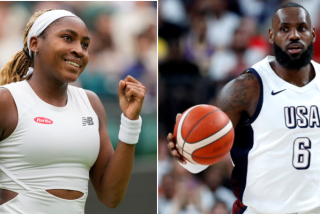FASHION : Athletes Compete in Style Wars
- Share via
When 400 American athletes are presented at Saturday’s opening ceremonies of the Winter Olympics in Albertville, France, they will wear outfits more stylish than those of Olympics past. The designs by Henry Grethel owe more to the influence of Italian master Giorgio Armani than to the labels you see at Big 5.
Grethel--the first American ready-to-wear designer to be commissioned by the U.S. Olympic Committee--scored the prestigious but unpaid assignment in 1990. From the start, he says, he hoped to create a look totally unlike the nylon running suits designed by Levi Strauss and Adidas for the 1984 and 1988 Olympics, respectively.
Large companies have dressed American athletes in the past because they could best afford the job. But for the 1992 Winter and Summer Olympics, committee members decided that American athletes should look as chic as their rivals, some of whom will be dressed by Giorgio Armani and Claude Montana.
It seems many U.S. athletes have left their outfits in the locker rooms after the games, forgoing the tradition of swapping wardrobes with competitors from other countries.
“I think the Olympic committee expected the outfits to be collectors items,” says Grethel. “But unfortunately, many of the athletes didn’t like them enough to take them home.”
Grethel’s participation came at the suggestion of JC Penney, an official Olympics sponsor whose stores prominently feature the designer’s clothing. The retail chain contributed $400,000 toward the $1.5-million-plus clothing budget in exchange for the right to sell Olympics-inspired fashions.
Grethel spent 15 months translating his vision from paper to playing field. His first designs--a cross between a sophisticated ski ensemble and the flight jackets worn by American astronauts--were summarily rejected.
“They were designed to look very all-American, but the committee feared terrorist attacks,” Grethel says, referring to concern about anti-American sentiment.
“They didn’t want anything pure red, white and blue. So I said, ‘OK, I’ll make them look Italian.’ ”
After reviewing more than a dozen additional sketches, the committee decided on a uniform that encompasses a combination of looks. Both men and women will wear variations on a navy-purple, white and cranberry star-patterned turtleneck with coordinating scarf and suede leather boots with subtle star motifs stitched on the toes.
The men will pair their hand-knit sweaters with purple-checked trousers, a double-breasted coat and felt fedora. The women will wear slim-fitting pants, a coat and a fedora.
After several American clothing makers turned down the chance to make the uniforms, the assignment went to firms in Italy and Hong Kong, prompting an outcry from U.S. unions.
“American manufacturing is mostly set up for large production,” Grethel explains. “And the work we were talking about, with the great variances in sizes--from men’s 36 short to 52 extra long to women’s 4 to 18--was like doing custom work. It just wasn’t cost effective for the American companies we contacted.”
More to Read
Go beyond the scoreboard
Get the latest on L.A.'s teams in the daily Sports Report newsletter.
You may occasionally receive promotional content from the Los Angeles Times.






